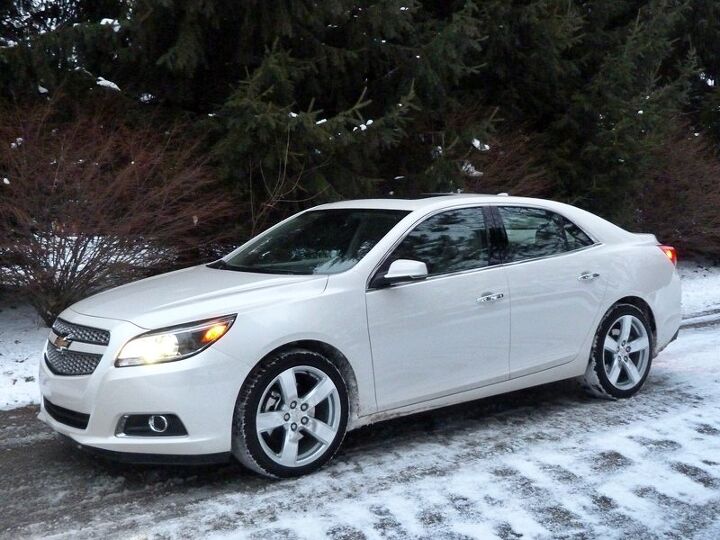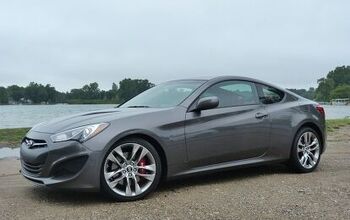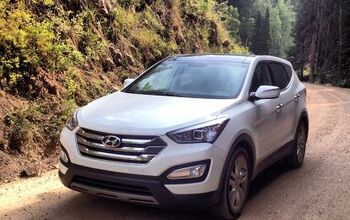Review: 2013 Chevrolet Malibu LTZ 2.0T
I wavered on whether to request a Malibu 2.0T from Chevrolet. My review of the 2013 Malibu in Eco form allegedly helped make it “ the most disliked car of the year,” and I’m not one to shoot fish in a barrel. But I did allow that the upcoming conventional engines could make for a better car, and the turbocharged engine’s additional 62 horsepower certainly couldn’t hurt.
The Malibu has too much visual mass in its overhangs to look right with the Eco’s 17-inch wheels. Add the 19s optional on the LTZ, and the car looks much better. It might not push the styling envelope the way the Fusion and Sonata do, but not everyone wants a coupe-like profile on their sedan. Compared to an Accord, Camry, Altima, or Passat there’s a little less appliance. The interior is mostly the same as in the Eco, just upgraded a bit with the LTZ. So materials and styling are perhaps at the top of the class, while rear legroom is at the bottom. Men of middling size can fit in back, but just barely, and they must do without their own air vents. Adding insult to injury, the trim of the rear doors is plainer and harder to the touch.
Chevrolet joins the latest generation of infotainment systems with MyLink. I’m no Alex Dykes, so I often struggle when attempting to figure out these systems. There’s no struggle with MyLink. Pairing with your phone is quick and easy. “Home,” “back,” and “fav” buttons never leave the top left corner of the screen. Each feature has a big square icon on the scrollable home page. Selections include a very well done Pandora app along with weather, movie times, and gas prices. You can’t control the HVAC or heated seats through the screen, but there’s no need to, with large, logically organized conventional buttons for this task. Those into safety nannies might find the Malibu’s arsenal lacking. Forward collision alert (useful) and lane departure warning (not) are offered together for $395, but the rearview camera is very basic and you can’t get obstacle detection or blind spot warning on the LTZ.
Its 2.0-liter four-cylinder engine might be turbocharged to yield 259 horsepower, but this Malibu isn’t—and isn’t intended to be—any sort of SS. Instead, as in the Fusion and Sonata, the turbo four fills the role previously performed by a V6, as an uplevel engine for regular sedan-buying folks. It performs this role well, accelerating the 3,660-pound car swiftly and quietly, with little evident lag. There’s also little torque steer to speak of, but this isn’t to say that front-wheel drive exacts no penalties. Attempt to accelerate even moderately hard out of a turn and the inside front Goodyear Eagle RS-A readily loses traction despite its 245/40WR19 spec. Also, the engine might be refined for a four, but low NVH isn’t the stuff of excitement. For an engine with character, seek a competitor with a V6.
With any engine, the Malibu’s only available transmission remains a six-speed automatic. The box can be manually shifted, but poor design makes this impractical. Not only is the shifter a few inches too far aft, but the manual shift toggle is on top of the knob–where your palm covers it. (In a related ergonomic oops, the armrest is too far rearward to be used while steering the car.) Luckily there’s little need for manual shifting. Unlike in pretty much every other application, in the boosted Malibu GM’s six-speed automatic generally manages to find the gear you want when you want it. Pilot the car con brio, and the transmission automatically joins the dance. No “sport” button is provided, nor is one needed.
How can the transmission combine responsiveness with EPA-pleasing efficiency? Well, it can’t. The official ratings are 21 mpg city, 30 highway, below the Fusion 2.0T’s 22/33 and the Sonata 2.0T’s 22/34. The V6s in the Accord and Altima also do better—so much for the inherent fuel economy advantage of a boosted four. The trip computer largely confirmed the EPA ratings, with a little over 30 in straight 75 mph highway driving and anywhere from 19 to 27 in the suburbs depending on the frequency of reds and the heaviness of one’s right foot. Go with the traffic flow, and you’ll split the difference.
GM’s official order guide notes no steering or suspension differences by engine. I was mystified, as the Malibu LTZ 2.0T steers and handles far better than I recall from my drive in the Eco. Tuning isn’t quite aggressive enough to qualify the car as a sport sedan, but its body motions are very well damped and its steering weights up naturally as the wheel is turned. Take this Malibu hard through a curve, and the nose feels only a touch heavy while the rear works to help the car rotate. An email to Chevrolet brought confirmation of my suspicions: the tuning of the springs remains the same, but the steering and dampers are firmed up with the turbo engine. Even with the firmer dampers—or, truth be told, because of them—the suspension dispatches patchy pavement with neither jiggle nor float. The performance tires aren’t as quiet as those on more pedestrian Malibus, but overall noise levels remain luxury car low.
If you’ve been paying any attention, you know that Chevrolet (along with Ford) no longer seeks to underprice the Japanese, much less the Koreans. Even after an unusual $365 mid-year price cut and without nav (which would add another $795), the almost fully-loaded tested car checks in just under $34,000. Do without the tricoat white paint and “cocoa fashion” interior trim, and you can shave $495 and $150, respectively. But no matter which way you cut it the Malibu LTZ 2.0T is not an inexpensive car. It does undercut a similarly-equipped Ford Fusion Titanium by $325 (a number suspiciously similar to that mid-year price cut), but adjust for feature differences using TrueDelta’s car value comparison tool and the Ford emerges about $500 less. A Hyundai Sonata Limited 2.0T is nearly $2,000 less before adjusting for feature differences, about $700 less afterwards. A Honda Accord Touring V6 checks in a few hundred over the Chevy, though.
Consider the Malibu LTZ 2.0T in practical terms, and it fares little better than the Eco. Its fuel economy is on the low side, its price is on the high side, and its rear seat would be only marginally competitive in the next segment down. But some cars just feel right to me, and the top spec ‘bu is one of them. Add in the car’s stylish, well-trimmed interior, and I found the Malibu LTZ 2.0T unexpectedly satisfying in my typical daily driving. I’m happy I decided to check it out. Midsize sedan buyers who care more about how a car looks and feels than practical considerations like fuel economy and rear seat room should do the same.
Chevrolet provided an insured car and a tank of gas.
Michael Karesh operates TrueDelta.com, an online provider of car reliability and real-world fuel economy information.
Michael Karesh lives in West Bloomfield, Michigan, with his wife and three children. In 2003 he received a Ph.D. from the University of Chicago. While in Chicago he worked at the National Opinion Research Center, a leader in the field of survey research. For his doctoral thesis, he spent a year-and-a-half inside an automaker studying how and how well it understood consumers when developing new products. While pursuing the degree he taught consumer behavior and product development at Oakland University. Since 1999, he has contributed auto reviews to Epinions, where he is currently one of two people in charge of the autos section. Since earning the degree he has continued to care for his children (school, gymnastics, tae-kwan-do...) and write reviews for Epinions and, more recently, The Truth About Cars while developing TrueDelta, a vehicle reliability and price comparison site.
More by Michael Karesh
Latest Car Reviews
Read moreLatest Product Reviews
Read moreRecent Comments
- V8fairy Not scared, but I would be reluctant to put my trust in it. The technology is just not quite there yet
- V8fairy Headlights that switch on/off with the ignition - similar to the requirement that Sweden has- lights must run any time the car is on.Definitely knobs and buttons, touchscreens should only be for navigation and phone mirroring and configuration of non essential items like stereo balance/ fade etc>Bagpipes for following too close.A following distance warning system - I'd be happy to see made mandatory. And bagpipes would be a good choice for this, so hard to put up with!ABS probably should be a mandatory requirementI personally would like to have blind spot monitoring, although should absolutely NOT be mandatory. Is there a blind spot monitoring kit that could be rerofitted to a 1980 Cadillac?
- IBx1 A manual transmission
- Bd2 All these inane posts (often referencing Hyundai, Kia) the past week are by "Anal" who has been using my handle, so just ignore them...
- 3-On-The-Tree I was disappointed that when I bought my 2002 Suzuki GSX1300R that the Europeans put a mandatory speed limiter on it from 197mph down to 186mph for the 2002 year U.S models.













































Comments
Join the conversation
Ok, so the back seat is small. Customers will either buy it and deal with it, or move on. IT'S BEEN NOTED EVERYWHERE. Move on!!!
It's a nice looking car with great features, but I can't help why I would pay nearly $10,000 more for a vehicle with only 1/3 of the passenger volume of my 2012 Toyota Sienna Van (base model). I paid only $25,500 for my van. Yes it's plain as vanilla inside but has all that I need. Heck I would rather have my old 2007 Malibu that I paid only 10,000 for. (bought a year old). The 2007 while not as flashy had 2 more cylinders and more space. What would last longer a turbo 4 or a V6? Other than nice styling the only accomplishments that I've seen automakers make in the last 10 years are: Reduced room, reduced visibility, more complication, higher repair costs. When was the last time you saw a Crossover with decent cargo space with all the seats up?